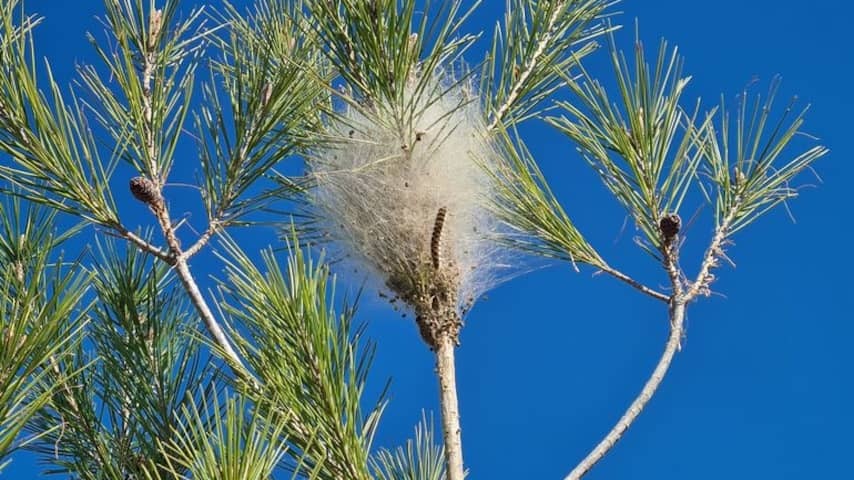
Butterflies of the Pine Processionary Caterpillar Have Been Found in the Netherlands for the first time, The Oak Processionary Caterpillar Knowledge Center Reported on Thursday. “The Oak Processionary Caterpillar Causes QUITE A BIT of Nuisance, and now there is a new variant added to that,” biologist Arnold van Vliet Told Nu.nl.
It Concerns Three Butterflies That Ended Up in Pheromone Traps in Limburg and Gelderland. “That Doessn’t Sound Like Much,” Van Vliet Admits. “But it clearly indicates that there are already many more butterflies in the country.” The Oak Processionary Caterpillar Knowledge Center Already Suspended that The Insects Occurred in the Netherlands. Now it has proof.
“It may take a few more years before it really starts to cause nuisance,” Says van Vliet. But he is sure that will be nuisance. Like the Oak Processionary Caterpillar, The Pine Processionary Caterpillar Releases Stinging Hairs That Can Lead To Complaints in Humans and Animals, Such as Burning Eyes, Skin Irritation and Shortness of Breath. The Pine Processionary Caterpillar Even Has Slightly More of these Hairs Than The Oak Processionary Caterpillar, With a Million Stinging Hairs.
Where the Oak Processionary Caterpillar Mainly Nests in Oak Trees, The Pine Processionary Caterpillar is Mainly Found in Conifers Such As Pines, Sprucs and Cedars. The Holm Oak and the Common Hawthorn are also menttioned in the literature. Because the two types of Caterpillars are in Different Trees, Van Vliet Speaks of A “Broadening of the Problem”. In Addition, They Behave Slightly Differently.
An Important Difference is that pine processionary caterpillars always pupate in the ground. They can walk in Procession for Days in Search of a Suitable Place to Bury Themselves. Duration this journey, they can also end up in Gardens, Meadows, Streets Or just in Houses and Schools.
Silvia Hellingman, A Colleague of Van Vliet, Followed a Procession of these Caterpillars in Spain That Anally Traveled More Than A kilometer before the Soil. It is Precisely Duration this walking phase that the Caterpillars Easily Lose Their Stinging Hairs, with Potentialy Nasty Consquences for People and Animals.
Impact of Caterpillars should not be underestimated
To determine how we can prepare for the nuisance, Van Vliet Believes it is good to keep an eye on the insects. For example, it is relevant WHETER SCHOOLS OR FESTIVAL Grounds are at risk and what the impact of such a process is.
Van Vliet Emphasizes That We Should Not Underestimate the Impact. “There are people who have had to temporarily leave their homes because it was simply no longer habitable due to the stinging hairs,” he says about the effect of the oak processionary caterpillar. The Pine Processionary Caterpillar Can Cause the Same Type of Nuisance.
“I think it is important that people realize that the pine processionary caterpillar is there. Without people immediately freaking out and spraying everything flat,” Says van Vliet. Spraying Always Causes Unnecessary Damage to Nature. Control with Natural Enemies is best, as is of done with oak processionary caterpillars. Think of Nesting Boxes for Tits on Trees that of Contain Oak Processionary Caterpillars.
A Bronze Wasp has also leg Seen in the Netherlands for the first time. That is a natural enemy of the pine processionary caterpillar. “It was already a bit of a mystery why it was found,” Says van Vliet. The Wasp Only Travels with the Pine Processionary Butterfly. Now that the butterflies of this Caterpillar have Been Found, the arrival of the bronze Wasp is much more logical and good news.
Oak Processionary Caterpillar Can also Still Cause Nuisance
There is a problem when it comes to natural enemies. “We have damaged our landscape so much that many of those natural enemies are also having a hard time,” van Vliet Explains. It is one of the reasons why we had so much nuisance from the oak processionary caterpillar in the past.
Do we actual have that insect under control? “No,” Says van Vliet. “We do see that they have decreased significantly in recent years, but that decrease is probably largely caused by the natural cycle.” The Number of Nests Seemed to Increase This Year. The Monitoring of the Butterflies That is currently running should show Whether we Will Have More Oak Processionary Caterpillars Again Next Spring.
It is Therefore Good to Continue to Monitor Both the Oak Processionary Caterpillar and the Pine Processionary Caterpillar and to Stimulate Natural Enemies. Van Vliet Emphasizes That Control is not about eradicating the species. “That is impossible and also undesirable.” Instead, IT is about ensuring that the Numbers are not too too Large, Especially in High-Risk Locations. “To Lower the Peaks So That We Have Less Nuisance.”